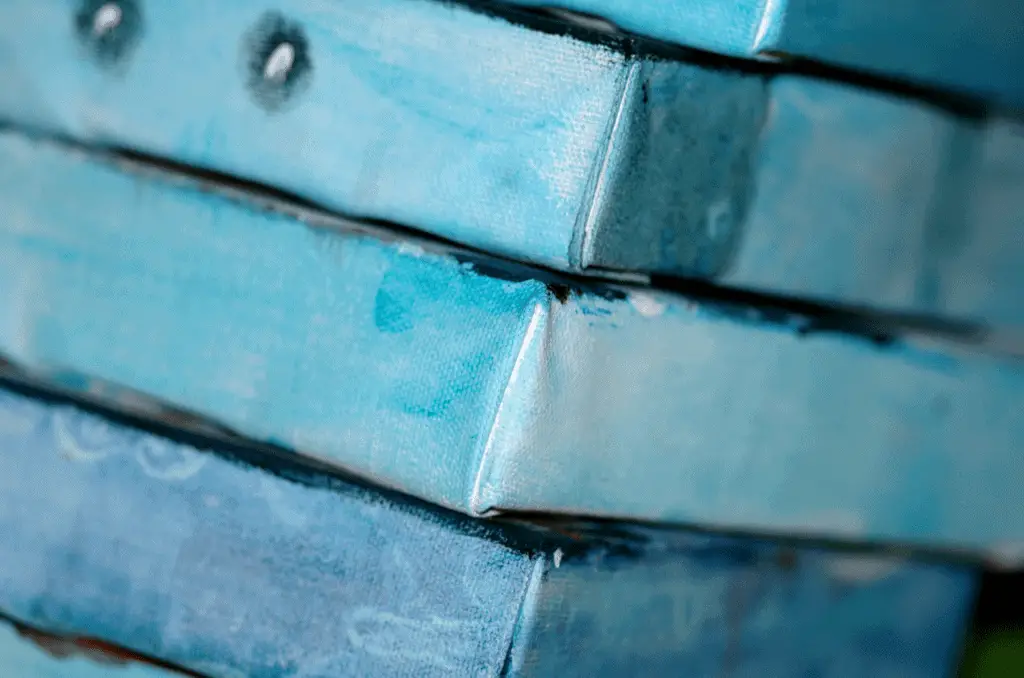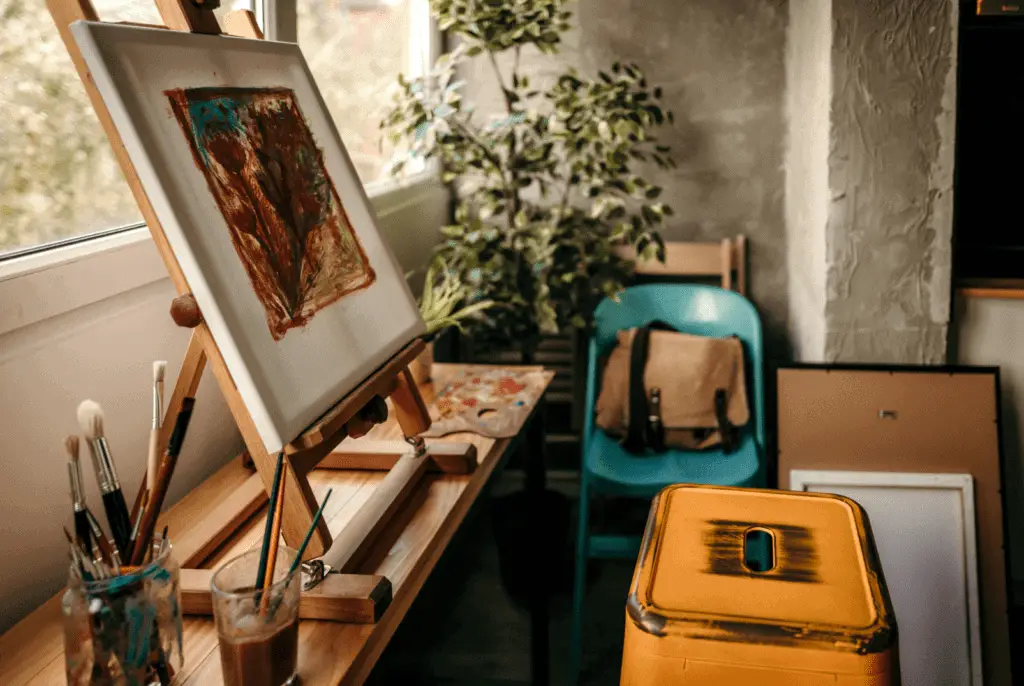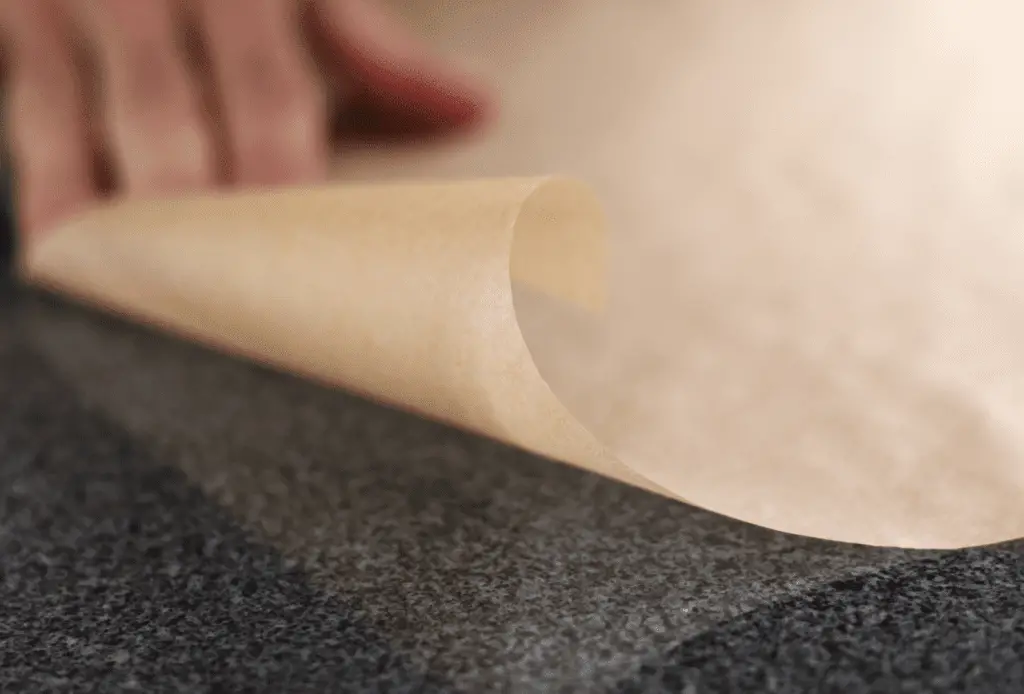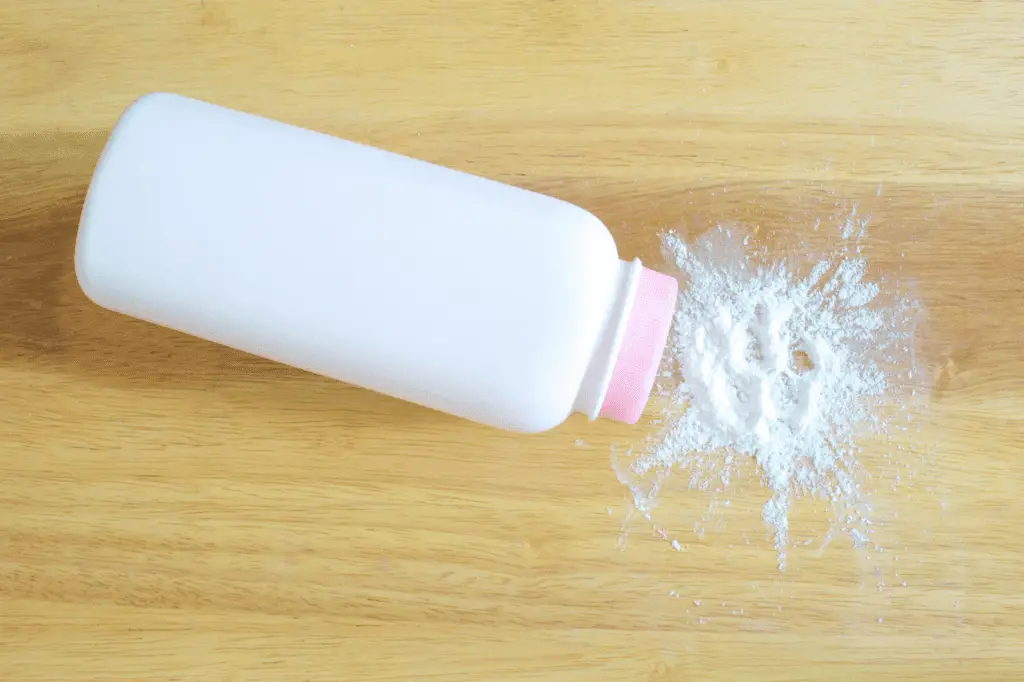How To Fix Sticky Acrylic Paint
Viscid or tacky acrylic paintings tin be annoying to all artists. If yous are a beginner, y'all might wonder, why your acrylic paint is sticky.
Acrylic painting is gummy when the painting is not fully cured, has poor ventilation, high humidity, uses low-quality paints, and thick painting layers. Avoiding the above aspects when painting, finishing with varnish or sealer, and using parchment papers in between paintings can fix this problem.
To prevent the acrylic pigment from sticking, all the steps from preparing the surface to applying a sealer or varnish are important. If you follow all of those steps correctly, your paintings will non be sticky or tacky.
Why acrylic painting is sticky?
Acrylic pigment becomes sticky betwixt its wet phase and fully cured phase. Although the paint is dry to the impact, in that location is even so water and solvent left in the pigment moving-picture show, causing stickiness. Poor ventilation, high humidity, low temperature, quality of paint, and thick paint layers may also contribute.
I take elaborated on each factor that can cause your acrylic painting to be sticky below.
Your painting has not been fully cured
There are 2 singled-out drying phases to acrylic pigment every bit mentioned before. In the first stage, the skin volition be formed over the surface of the paint film and the paint will be 'dry to touch'. This phase is very short and may even be seconds when the pigment is practical very thinly. If paints are practical thickly, the first phase may last for i 24-hour interval or more.
On average acrylic paint will be dry to touch within 20 to 30 mins. However, what near artists are not aware of is the 2d phase of drying, which is called the 'curing menstruum'. The curing flow is longer than the showtime phase of drying.
Stickiness happens when acrylic paint is not fully cured. When there is still water and solvent left in the paint flick and the paint hasn't hardened fully, acrylic paint will be mucilaginous. For very thin acrylic painting layers, the curing menses will be a few days and well-nigh deadening-drying acrylic paints accept a curing time of 30 days. For about paints expect at least 3 weeks to fully cure and harden the pigment film.
Paint films of i/4 inch thickness or more will take months and even years to fully cure. As well the concrete properties of acrylics such as adhesion, hadness and clarity, volition not fully develop if the pigment film is non fully cured.
Aureate Artist Colors, Inc.
I have written a whole article on 'How long acrylic pigment to cure? (Comprehensive answer)'. You will go to know more almost curing, even the procedure acrylic pigment goes through to dry and cure.
Many environmental factors can influence drying or curing fourth dimension and stickiness. These are temperature, humidity, and airflow or ventilation. Artists tin can control these factors and use them to their advantage and reduce the stickiness of paintings. I accept elaborated on each of them below equally factors contributing to the stickiness of acrylic paint.
Poor ventilation or high airflow affects drying time causing stickiness
Poor ventilation can also cause, gummy paintings. Peculiarly if you are using a canvas pad or an acrylic pad for painting. You might shut the painting volume after finishing the painting and information technology feels dry to manus. But after endmost the volume, at that place is poor ventilation, before the painting is fully cured. When yous reopened the book and flip the pages, you will run into the pages are tacky or stickier.
Moderate and steady airflow is the near favorable for drying. Keeping your paintings in a strong airflow or breeze can reduce the drying process and pic germination. Thus it volition cause the painting to exist sticky and even, wrinkling or cracking of acrylic paint.
I accept written a whole commodity virtually why acrylic paint is non drying. There you can find all the factors affecting drying fourth dimension in more than detail.
Keeping paintings in high humidity slows the drying process
Relative humidity represents the corporeality of h2o vapor in the air. It is expressed as a percentage of bodily water vapor in the air to the maximum amount of h2o vapor that can be in the air at that temperature. When there is high humidity, it will feel wetter outside.
If the relative humidity is higher than 75% it volition non exist skillful for your painting. When there is more water vapor in the air, it will brand it harder to evaporate water or solvent from the paint film, thus slowing the drying or curing procedure. The same tin can happen if a humidifier is in place. This tin cause the stickiness of your acrylic painting.
Lower temperatures touch on drying time causing stickiness
Lower temperatures, beneath 49oF (9oC) bear upon acrylic film formation. It volition bear upon the ability of the acrylic polymer binder to demark the pigments together and form a paint film on the surface. Thus, it may cause stickiness, powdered films, and less adhesion to the surface.
The ideal temperature for proper film formation and drying would be seventy to 90oF during the drying or curing menses.
Overheating your acrylic paint layers with a hairdryer or a oestrus gun can retard the moving-picture show formation. It can burn the acrylic pigment film and may cause bubbles. Still, if you did not overdo it, it can aid pigment film to dry quickly.
Applying paint likewise thickly in layers causes stickiness
When yous employ paint likewise thickly on a surface, information technology will have a long time to fully dry or cure. This is because thick layers of paint have more water inside the paint picture show, that needs to be evaporated. But you can adjust the environmental conditions to your advantage and speed upward the drying process. Every bit an example, you can employ a pilus drier to speed up the drying process.
If the painting is non fully dry, information technology may feel sticky or tacky. Notwithstanding, this does not limit artists from applying layers of paint when the underpainting is however dry or feels dry to the bear upon. If applied paint thickly, you demand to allow it fully cure or dry for weeks or months to reduce the stickiness of the painting.
Also applying thick layers of paint on a less porous hard surface such as plastic, metal, or drinking glass tin can take weeks or months to dry out properly. Because these surfaces accept no pores that allow h2o and solvent to escape pigment film easily.
The quality of paints tin cause stickiness
Sometimes the paint quality tin affect stickiness, peculiarly if you are mixing different quality paint. E. g., mixing craft quality paints with artist quality paints.

How to make acrylic paintings less viscous or tacky?
Now that you know a bunch of different reasons why your acrylic painting can be sticky, let'due south explore the x easiest ways how to make your acrylic paintings less viscid or tacky.
i. Varnishing reduces stickiness of painting
This is so far the all-time pick for gummy paintings. Varnish creates a barrier between the environment and the painting. It will protect your paintings from moisture and prevent yellowing with historic period. Virtually people utilize varnish as a solution for tacky or glutinous paintings.
Yous can also apply a sealer for this purpose. Notwithstanding, make certain you get a water-based sealer or varnish. Using oil-based varnish or sealers tin can ruin your paintings.
Before yous varnish a painting, allow the painting to fully cure. Every bit mentioned before, the curing time of acrylic pigment is between 3 to 4 weeks. It volition permit all the moisture to escape from the paint. Otherwise, moisture will be sealed in the painting with varnish or sealer and cause cloudiness of painting and poor adhesion of varnish.
Also if you take painted on a nonporous substrate such as glass, metallic, or plastic, it will make solvents and water difficult to escape from the painting unlike with a canvas. In this case, also, let the paint to fully dry or cure for a month and and so apply the varnish or the sealer.
Using a varnish or sealer will as well make your paintings vibrant. It volition requite a ameliorate finishing to the painting. Matte spray sealers can also work well. 1 of the best sealers you lot can employ is Krylon Satin Finish. The brand Krylon is ane of the artists' favorites. Information technology is wet-resistant and non-yellowing. Following is a link to buy it from Blick Art Materials: Krylon Satin Finish Spray Fixative
ii. Allow the paint to fully cure
This is the simplest of all tips. If your paint sticks even after allowing it to dry overnight, the best thing is to allow them cure for at to the lowest degree 3 to 4 weeks. Make sure y'all allow skilful ventilation in the curing period. If your painting is on a sheet pad or an art journal, keep the book open. Yous tin too keep something below the painting to hold the painted page up, for better ventilation.
If y'all are painting on a canvas, practise not stack paintings together earlier allowing them to fully cure. This will solve the sticking problem, even without varnishing the painting. Sometimes paintings will cease being sticky when fully cured, even without good ventilation. When the pigment is cured, at that place is no reason for it to stick as there is no water or solvent left.

3. Utilise high-quality paints
Some acrylic paint brands and types are tackier than the other types. More often than not artist quality paint brands such every bit Liquitex and Gilt are less tackier than craft-quality paint. It is ever better to buy artist-quality pigment for painting. It will brand your painting vibrant and solve the sticking trouble. Too, brand sure you do not mix different quality paints. As an instance, mixing craft quality paint with artist quality paint.
Below I accept included links for the best deal to buy a Golden heavy body acrylic set and Liquitex professional heavy torso acrylic set from Blick Fine art Materials. It will take your paintings to the next level.
- Golden heavy body acrylic
- Liquitex professional heavy trunk acrylic
4. Maintain proper environmental conditions
Always try to paint in a less boiling surroundings. Painting in a very hot or cold environment reduces the drying of the paint and makes the paint sticky. Ideally, it is best if you can paint in an environment between 40 to 70 pct humidity. You lot can check the humidity at your painting place with a hygrometer.
You tin also find the all-time humidity condition for the paint brand on the characterization of the paint tube. If you detect that humidity is loftier in the area, use a dehumidifier or find a place with less humidity to paint.
Humidity is high after rain and it is best to avoid painting after the rain. Always paint on very dry surfaces. Particularly if y'all are trying to paint on a wet-absorbing surface such as wood, concrete, or a wall. Make certain these surfaces are fully dry, before applying a primer or paint.
Practise not paint in a too hot or likewise common cold surround. The best temperature for painting is between seventy to 90 degrees of Fahrenheit. Ever check with your paint label for the all-time temperature for your paint. If y'all retrieve you lot painted in a very cold environs, warm the room up to speed up the drying process.
Post-obit is the best deal for a digital thermometer and humidity gauge from amazon. You tin can buy information technology with the following link: ThermoPro TP50 Digital Hygrometer Indoor Thermometer
five. Use wax newspaper in betwixt paintings
You lot might have faced the tacky problem when storing pigment, on top of each other. If you don't like to varnish, you can employ glassine paper in between the paintings. You can also employ parchment paper or any wax newspaper betwixt paintings when storing.

Withal as said before, allow expert airflow until the painting is fully cured. Information technology will not be a proficient idea to stack the paintings or pack them together during the drying or curing catamenia. Following is a link to purchase Glassine Fine art Newspaper from Blick Art Materials: Legion Interleaving Paper
6. Play around with the acrylic mediums
Some artists observe, that when they change the mixing mediums for acrylics, the sticking problem solves. Play around with acrylic mediums. Effort a matte medium with acrylics, instead of water. Y'all tin likewise endeavor gloss mediums as well. These mediums support the acrylic polymer bonds, dissimilar water. You tin add together more than mediums with less pigment without breaking the polymer binder of acrylics.
Too much h2o tin can too impact the drying time. If y'all add more than 25% of water to the acrylic paint, the polymer bonds in acrylics will break. Thus acrylics will not dry into a plastic layer equally they should. This can cause stickiness as the pigment does not dry out properly due to excess wet.
Following is the link to an acrylic medium set from Blick Art Materials from the best creative person brand Aureate. Even though you may retrieve you don't need acrylic painting mediums now, you volition need them to level upward the expect and the properties of your painting such equally reducing the stickiness of paintings.
- Golden Matte Mediums
- Gilt Gloss Medium
- Aureate Regular Acrylic Gel Mediums
Stickiness can besides happen if paint is contaminated with alcohol. Exercise non mix your paint with whatever products that accept alcohol in information technology.
I have written a whole article about the 17 pros and cons of acrylic paint. You tin can notice all the of import aspects of acrylic paint there.
7. Let the bottom painting layers to dry
When you are painting, e'er permit the lesser painting layers to dry, before applying the top paint layer. This way, moisture will non exist trapped inside the painting layers below. This phenomenon is chosen 'blocking' meaning you are blocking the paint from drying.
Stickyness happen, when you lot apply as well many coats of painting, too thickly, likewise quickly.
-Viktor
If you observe yourself applying thick layers of painting and feel stickiness, consider applying paint thinly. Most of the time, if you are using an artist's quality pigment, you do not need to utilize thick layers of paint unless you do a technique such as an impasto. Usually, the low-quality, student or craft-course pigment has this problem.
Artist'due south quality paints are highly concentrated in pigments. You can apply very little paint and burnish the paint onto the canvas with a castor. Little pigment goes a long way with high-quality paint. You can get artists' quality paint from brands such as Golden, Liquitex, Winsor and Newton, and Amsterdam.
If yous are already applied pigment in thick layers, the solution will be to let the pigment to dry fully or cure. Permit the paint to cure for one calendar month and see the results.
8. Have adept ventilation in the painting
If you are using an art journal or canvas pads for painting ventilation becomes a problem. About artists may non realize this. They will just close the canvas pad or the fine art journal after painting. Although the paint is dry to the touch, it may not be fully cured.
After painting, keep the painting book open for the dark before closing them. This fashion you can prevent a lot of stickiness. Allowing the paint to cure for 1 month with good ventilation equally mentioned earlier likewise helps.
In full general, you should not proceed the paintings in a closed environment, such as a box or a closet, or may shop them in a stack, until they are fully cured. Your paintings need to accept a good airflow or ventilation from front and back until it is fully cured. As well, think to maintain proper temperature and humidity while allowing proficient airflow.
Never roll your paintings and store them before fully curing. Information technology will not permit proper airflow and crusade stickiness. Only it may also cause the paint film to crack upon unrolling usually at a lower temperature.
nine. Apply talcum powder on paintings

Y'all tin apply talcum powder to paintings to speed upwardly the drying process. it volition non feel sticky anymore. Nevertheless, you demand to practice this on a finished painting. If yous utilize pigment on top of pulverization, the paint may peel off. You can use a wide gesso brush or even around makeup brush to apply powder on pinnacle of the paintings.
If you exercise not like the expect of powder on the painting, solutions volition exist to fully cure the painting and apply varnish to them. You can also apply wax paper in betwixt the paintings.
10. Prepare the surface before painting
Priming the canvas before painting is also important. Yet, you need to use a primer that is uniform with paint. Brand sure you don't use an oil-based primer. When using acrylic paint use gesso. Gesso volition foreclose the absorption of paint into canvass allowing us to become the all-time results with a little paint. Information technology will also allow shine paint application.
This will prevent sticky pigment due to thick layers of pigment. Additionally, gesso will aid paint meliorate stick to the canvass and foreclose peeling. Make sure your sheet does not have any dust or grease. If there is any grit or grease, lightly sand the canvas and use gesso. Do this even though the canvas is pre-primed with gesso. Information technology will make the paint ameliorate attach to the surface.
I wrote a whole article about what surfaces volition acrylic paint not stick to and how to gear up almost any surface for painting. It will guide you to paint anything with acrylics and continue information technology off!
Decision
Although sticky or tacky acrylic paintings are annoying, there are many ways to fix them. The best way to set is by varnishing or sealing the painting. You can also allow the paint to cure for one month. If y'all exercise not like both of these solutions, utilise wax paper in between the paintings to preclude stickiness. Always, set the surface well, paint in proper environmental weather and utilise creative person-quality acrylics. Following these steps volition assistance yous solve the trouble easily.
I wrote a serial of articles on mutual acrylic paint questions and answers: part i and function 2. So that you know answers to any acrylic pigment problem like acrylic pigment beingness mucilaginous even before your face up it!
How To Fix Sticky Acrylic Paint,
Source: https://paintinggal.com/why-is-your-acrylic-paint-sticky-10-best-ways-to-fix-it/
Posted by: cookgerentow.blogspot.com


0 Response to "How To Fix Sticky Acrylic Paint"
Post a Comment